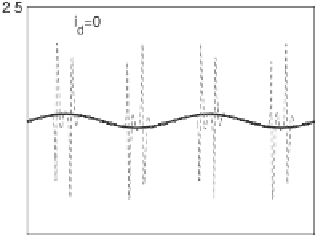Environmental Engineering Reference
In-Depth Information
Figure 4.8
Disturbance current and steady-state voltage tracking error with the nominal load when the
PWM block and the inverter were modelled as a unity gain with saturation
per carrier cycle. The THD of the output voltage
u
o
is around 1
.
37%, almost all due to the
switching effect.
When the system was subjected to a disturbance current
i
d
shown in Figure 4.8(a), which
has the typical shape of the distortion caused by a capacitive rectifier, the simulation result
is shown in Figure 4.8(b). Although the peaks of
i
d
were about half the nominal load
current, the system had a good capability to reject such a disturbance. Indeed, although
the THD of the output current
i
o
of the inverter was 16
.
38%, the THD of the microgrid
voltage was only 0
16%. When a detailed model of the PWM block and the inverter was
used, the THD of
i
o
increased slightly to 16
.
.
45% while the THD of the microgrid voltage
became 1
.
39%.
4.5.2 Response to Load Changes
Simulations were done when the load was a pure resistor of 50
, which consumed about
10% of the load power used in the previous subsection. The PWM block and the inverter
were modelled as a saturation block. The output voltage is shown in Figure 4.9(a) and the
tracking errors, with and without the disturbance current shown in Figure 4.8(a), are shown in
Figure 4.9(b). No performance degradation can be observed from these figures.
Another simulation explored the transient responses when the load was changed from the
nominal load to a pure resistor of 50
when
i
d
was set at 0. The tracking error and the current
i
o
are shown in Figure 4.10. The load was changed at
t
301sec (when the load current was
close to 0 so that the resulting spikes were small). The system reached the steady state within
4 mains cycles and the dynamic error was less than 1
=
0
.
.
5V.
4.5.3 Response to Grid Distortions
A typical grid voltage is flattened at its peaks. Such a grid voltage of
u
g
=
325 sin
ω
t
−
32
.
5sin3
ω
t
−
32
.
5sin5
ω
t
, as shown in Figure 4.11(a), was used as an example. The tracking










































































































Search WWH ::

Custom Search